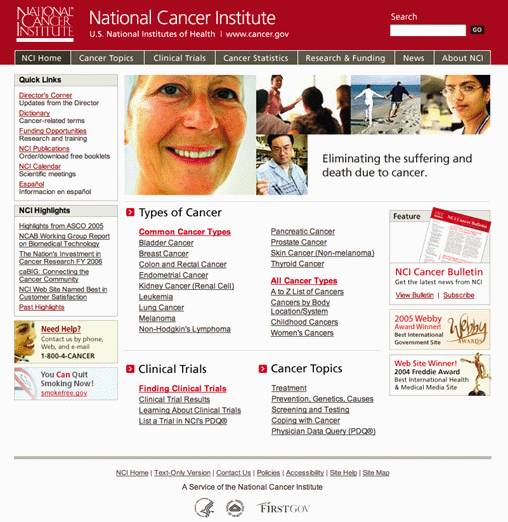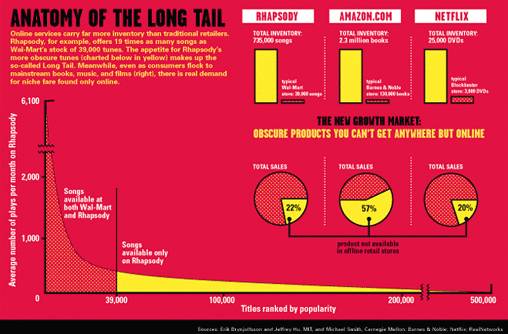Section 1.3. Business Value
1.3. Business ValueLet's say you're unmoved by the idealistic call for greater literacy. Our children may be our future, but you've got budget problems and business challenges today. Why should you care about findability? Why should you learn more about social software, semantic webs, and search engine optimization? What can findability do for you? We begin our quest for business value in the unlikely domain of a federal government agency. Yes, we're back at the National Cancer Institute where I recently had the good fortune to collaborate with a great team of people on redesigning the cancer.gov web site. I was brought in to lead the information architecture strategy. My goals were to improve navigation and usability, and reduce the number of clicks required to access key content. The in-house team at NCI had done a great job analyzing patterns of use. They understood who visits, why they visit, and where they spend their time. They knew the majority of site visitors are people recently diagnosed with cancer (and their friends and family members). And their data showed the home pages for specific types of cancer were among the most visited. So, among other goals, they wanted to reduce the time and number of clicks it took to navigate from the NCI home page to cancer type home pages. Now, being a findability fanatic, I couldn't help inquiring about how people find the web site in the first place. My clients didn't have much data on this topic, but they told me not to worry about this type of findability. Our site comes up as the first or second hit for searches on "cancer" on Google and Yahoo! they told me, so we're all set. But I did worry, and I did a bit of digging. I used Overture's Search Term Suggestion Tool to get a sense of the types of cancer-related searches being performed on public search engines. Sure enough, the generic query on "cancer" was the single most popular search (i.e., 180,000 queries per month). But queries on specific types of cancer were also very common (e.g., 132,000 on "breast cancer" per month). In fact, when you totaled the searches on specific types of cancer, they outnumbered the generic searches by a 5:1 ratio, as Figure 1-1 shows. This makes sense. If you're diagnosed with breast cancer, you're very likely to search on "breast cancer" rather than explore the more general category of cancer. Figure 1-1. General and specific search frequency Yet when I tried Google and Yahoo! searches on "breast cancer" and "prostate cancer" and "mesothelioma," cancer.gov didn't come up in the first screen of results. It was drowned out by a multitude of more specialized, more commercial, less detailed, less trustworthy web sites. For users with these specific queries, the NCI site, shown in Figure 1-2, was essentially unfindable. In my opinion, this was a major problem. In fact, I told my clients that if they had to choose between having me redesign the information architecture and having a search engine optimization firm improve cancer type home page visibility for the most important and common cancer-related keyword searches, I'd recommend the latter. Fortunately, my clients weren't forced to choose. In fact, we worked together on a holistic findability strategy to make it easier for users to find the site, to find the site's content, and to find their way around the site. And, in the year since this cancer.gov redesign, the National Cancer Institute has won a Webby Award and a Freddie Award and has climbed to the very top of the American Customer Satisfaction Index for E-Government. This goes to show that good things happen when you focus on findability. But why hadn't my clients identified and solved their findability problems sooner? Because, like so many other design teams, they viewed their responsibility from a top-down perspective. Can users find what they need from the home page? It's an important question, but it ignores the fact that many users don't start from the home page. Powerful search tools, directories, blogs, social bookmarks, and syndication services are moving deep linking and content sampling from exception to rule. Many of your users will never visit your home page. And some may not even realize the answers they want are on the Web. People often assume they'll have to visit a library or ask a professional, and for lack of time or money, they get stuck. Can users find what they need from wherever they are? That's the multi-channel communication question we should be asking. At NCI, the team had to look beyond the narrow goals of web site design, to see their role in advancing the broader mission of disseminating cancer information to people in need. They had a blind spot when it came to findability, and it's a weakness shared by many if not most organizations today. Executives want a web site that looks good. And thankfully, most now want a web site that's usable. But few executives understand the Web and how people use it well enough to recognize the vital importance of findability. This is no small oversight. In a marketplace that's shifting from push to pull, findability is a big deal. As a pioneer of Internet search engine advertising, Overture recognized this opportunity early and capitalized on it to the tune of $1.6 billion (the value of their acquisition by Yahoo!). Paco Underhill, the Figure 1-2. The National Cancer Institute's home page guru of the science of shopping, acknowledges this transition in his best-selling book, Why We Buy:
In a world where it's getting harder to reach consumers, shouldn't businesses make it easier for consumers to reach them? Yet, when it comes to findability, most business web sites have major problems. Poor information architecture. Weak compliance with web standards. No metadata. Content buried in databases that are invisible to search engines. From sales to support, many firms could get a great return by investing in findability. But the fault lines extend well beyond web design. Findability is transforming the marketplace. For those who pay attention, the signals of tectonic shift are self-evident in what Chris Anderson of Wired calls the Long Tail, shown in Figure 1-3. In his colorful analysis of the "millions of niche markets at the shallow end of the bitstream," Anderson explains how the virtually unlimited selection of online catalogs is shaking up our economy:
Figure 1-3. Anatomy of the Long Tail As venture capitalist Kevin Laws puts it: "The biggest money is in the smallest sales." In an economy where it takes almost nothing to produce and stock one more item, the competitive challenges and big wins are in findability. How do we reduce search costs and time to find? How do we use social software to drive demand down the Long Tail? Amazon, eBay, Google, iTunes, and Netflix are all Long Tail. Each of these early adopters uses search in support of mass customization. They know you can't buy what you can't find. And they understand this is a tail that will ultimately wag the dog. How will your business respond? The search space is huge. The potential for top line growth is big. But you better jump now while there's still plenty of room at the bottom.[*]
But wait. Don't move too fast. Or you just might wander off a cliff. In matters of findability, the siren song of technology has lured many to destruction. Though our attention is drawn to the fast layers of hi-tech, the map to this maze is buried in the slow layers of human behavior and psychology. It's not enough to focus on the I in IT. We must also lose the C in HCI. Because ambient findability is less about the computer than the complex interactions between humans and information. Findability is the biggest story on the Web today, and its reach will only grow as the tidal waves of channel convergence and ubiquitous computing wash over our shores. We will use the Web to navigate a physical world that sparkles with embedded sensors and geospatial metadata, even as we diminish the need to move our bodies through space. Mobile devices will unite our data streams in an evolving dance of informed consumers seeking collective intelligence and inspiration. And in this ambient economy, findability will be a key source of competitive advantage. Finders, keepers; losers, weepers. |
EAN: 2147483647
Pages: 87
 ]
]